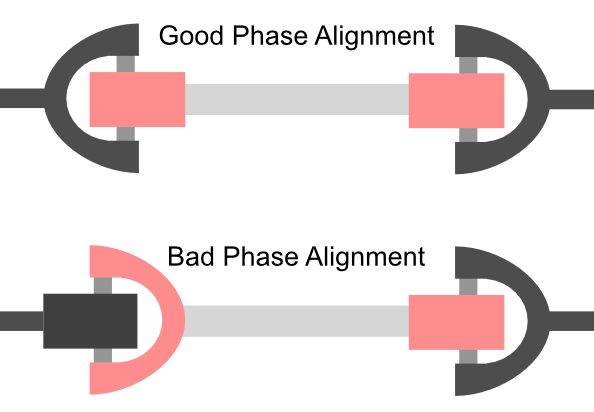This is what your double kick pedal is most likely. 2 U-Joints that connect a slave pedal to the main pedal.
As can be seen in the video, if the angle of the 2 joints is not identical, you can be left with a bothersome lumpy-feel in the movement of your slave pedal.
After the break I’ll show you a couple easy ways to make sure that your U-Joint angles are setup identically to allow for optimal feel.
Contents
The problem
The issue presented is two fold, and both problems must be addressed: Angle and Phase.
Angle

As referenced in the initial video, if your the angles of your u-joints are not identical, then you the slave action will be elliptical.
The ideal situation is one where both u-joint angles are identical. This allows the elliptical motion of the slave joint to be canceled out by a second u-joint that is in phase.
Phase

My kick pedal won’t actually let me set it up out of phase. Many pedals do allow you to do this, so I created a drawing. A poor one, but hopefully it gets the point across.
The forks of the u-joints on the intermediate shaft need to be matching in their rotation on the shaft. If the joints are not in phase, then the elliptical motion transfer will become much worse.
I’ve seen a number of beginning drummers with out of phase u-joints. It makes the slave’s motion feel like you’re pressing in to a piece of plastic that suddenly breaks halfway through the motion. Combine this with incorrect angles and it’s no wonder that some people have such a terrible time learning double kick!
To pile it on, many higher quality pedals only will assemble with the joint phase correct. Beginners often have poor quality cheaper pedals that come with no instructions. How frustrating!
Fix it.
Method 1 - Paper
The cheapest, but least reliable method is simply a sheet of paper. If you never move your drumset, then this is the one-shot solution that requires barely any effort and no money. Go cut up a piece of junk mail if you need to.
Simply cut a piece of paper to match the angle of one side, then transfer the angle to the other u-joint.
See below for how to use it.
Method 2 - Credit Card (or wood)

The more durable and mobile solution is to cut a credit card to shape. I use a piece of wood as shown in the above picture.
It’s important that you show the angle jig directly to the u-joint’s forks. If you reference off of the shaft or a connector piece then it can be difficult to reference identically on both sides.
If you have your pedals on a carpet and your pedals have velcro on the bottom, I suggest putting a sheet of paper under the slave pedal while you make adjustments. This will stop the velcro from engaging the floor. When you’re done you can slide out the paper without ruining your adjustments.
In my last 20+ years of drumming I’ve found that ideal common angles are from 5° to 13°. The angle of your jig will be 50% of the total angle of the slave pedal relative to the main pedal. I use an angle of 10.5°, but that is not important.
Conclusion
If you’ve never explored this, it’s very likely that you will see a great increase in the smoothness of your slave pedal’s action.
Even a difference of 0.5° on a single joint can create a noticeable elliptical action on the slave pedal. Be exact, be patient and rock on!
Support me!
This post took 5 hours to research, photograph, write and edit. If you appreciate the information presented then please consider joining patreon or donating!
